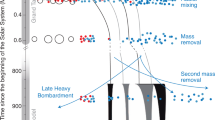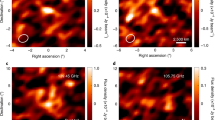Abstract
Observations over the last decade have revealed the existence of a large number of bodies orbiting the Sun beyond Neptune1. Known as the Kuiper-belt objects (KBOs), they are believed to be formed in the outer reaches of the protoplanetary disk around the young Sun, and have been little altered since then. They are probably the source of short-period comets2. The KBOs are, however, difficult objects to study because of their distance from earth, so even basic physical properties such as their sizes and albedos remain unknown. Previous size estimates came from assuming an albedo with the canonical value being 0.04. Here we report simultaneous measurements of the thermal emission and reflected optical light of the bright KBO (20000) Varuna, which allow us to determine independently both the size and the albedo. Varuna has an equivalent circular diameter of D = 900+129-145 km and a red geometric albedo of pR = 0.070+0.030-0.017. Its surface is darker than Pluto's, suggesting that it is largely devoid of fresh ice, but brighter than previously assumed for KBOs.
This is a preview of subscription content, access via your institution
Access options
Subscribe to this journal
Receive 51 print issues and online access
$199.00 per year
only $3.90 per issue
Buy this article
- Purchase on Springer Link
- Instant access to full article PDF
Prices may be subject to local taxes which are calculated during checkout


Similar content being viewed by others
References
Jewitt, D. & Luu, J. in Protostars and Planets IV (eds Mannings, V., Boss, A. & Russell, S.) 1201–1229 (Univ. Arizona Press, Tucson, 2000).
Duncan, M., Quinn, T. & Tremaine, S. The origin of short-period comets. Astrophys. J. 328, L69–L73 (1988).
Campins, H., A'Hearn, M. & McFadden, L. The bare nucleus of comet Neujmin 1. Astrophys. J. 316, 847–857 (1987).
A'Hearn, M., Campins, H., Schleicher, D. & Millis, R. The nucleus of Comet P/Tempel 2. Astrophys. J. 347, 1155–1166 (1989).
Millis, R., A'Hearn, M. & Campins, H. An investigation of the nucleus and coma of Comet P/Arend-Rigaux. Astrophys. J. 324, 1194–1209 (1988).
Fernandez, Y. et al. Physical properties of the nucleus of comet 2P/Encke. Icarus 147, 145–160 (2000).
Allen, D. A. Infrared diameter of Vesta. Nature 227, 158–159 (1970).
McMillan, R. & Larsen, J. 2000 WR106. Minor Planet Electronic Circular 2000-X02 〈http://cfa-www.harvard.edu/iau/mpec/K00/K00X02.html〉 (2000).
Knofel, A. & Stoss, R. 2000 WR106. Minor Planet Electronic Circular 2000-Y45 〈http://cfa-www.harvard.edu/iau/mpec/K00/K00Y45.html〉 (2001).
Barger, A., Cowie, L. & Sanders, D. Resolving the submillimeter background: the 850 micron Galaxy counts. Astrophys. J. 518, L5–L8 (1999).
Jewitt, D. C. & Luu, J. X. Submillimeter continuum observations of 2060 Chiron. Astron. J. 104, 398–404 (1992).
Spencer, J. R., Lebofsky, L. A. & Sykes, M. V. Systematic biases in radiometric diameter determinations. Icarus 78, 337–354 (1989).
Jewitt, D. C. & Kalas, P. Thermal observations of Centaur 1997 CU26. Astrophys. J. 499, L103–L106 (1998).
Thomas, N. et al. Observations of the trans-Neptunian objects 1993 SC and 1996 TL66 with the infrared space observatory. Astrophys. J. 534, 446–455 (2000).
Lebofsky, L. et al. A refined ‘standard’ thermal model for asteroids based on observations of 1 Ceres and 2 Pallas. Icarus 68, 239–251 (1986).
Harris, D. L. in Planets and Satellites (eds Kuiper, G. & Middlehurst, B.) 272–342 (Univ. Chicago Press, Chicago, 1961).
Russell, H. N. On the albedo of the planets and their satellites. Astrophys. J. 43, 173–195 (1916).
Farnham, T. (20000) 2000 WR_106. IAU Circular 7583 (2001).
Bowell, E. et al. in Asteroids II (eds Binzel, R., Gehrels, T. & Matthews, M.) 524–556 (Univ. Arizona Press, Tucson, 1989).
Holland, W. S. et al. SCUBA: a common-user submillimetre camera operating on the James Clerk Maxwell Telescope. Mon. Not. R. Astron. Soc. 303, 659–672 (1999).
Landolt, A. UBVRI photometric standard stars in the magnitude range 11.5–16.0 around the celestial equator. Astron. J. 104, 340–371 (1992).
Keller, H. U. et al. Comet P/Halley's nucleus and its activity. Astron. Astrophys. 187, 807–823 (1987).
Altenhoff, W. J. & Stumpff, P. Size estimate of ‘asteroid’ 2060 chiron from 250GHz measurements. Astron. Astrophys. 293, 41–42 (1995).
Davies, J., Spencer, J., Sykes, M., Tholen, D. & Green, S. (5145) Pholus. IAU Circular 5698 (1993).
Tholen, D. & Buie, M. in Pluto and Charon (eds Stern, S. A. & Tholen, D. J.) 193–220 (Univ. Arizona Press, Tucson, 1997).
Acknowledgements
This work was supported by the National Science Foundation. H.A. is supported by a James Clerk Maxwell Telescope fellowship. We thank the Institute for Astronomy Director for allocating target of opportunity JCMT time and D. Sanders for donating UH telescope time.
Author information
Authors and Affiliations
Corresponding author
Rights and permissions
About this article
Cite this article
Jewitt, D., Aussel, H. & Evans, A. The size and albedo of the Kuiper-belt object (20000) Varuna. Nature 411, 446–447 (2001). https://doi.org/10.1038/35078008
Received:
Accepted:
Issue Date:
DOI: https://doi.org/10.1038/35078008
This article is cited by
-
A planet more, a planet less?
Nature (2006)
-
The binary Kuiper-belt object 1998 WW31
Nature (2002)
Comments
By submitting a comment you agree to abide by our Terms and Community Guidelines. If you find something abusive or that does not comply with our terms or guidelines please flag it as inappropriate.



